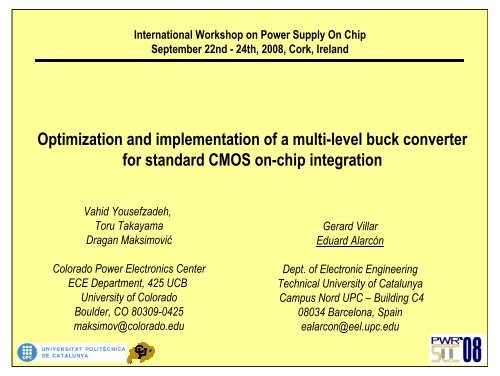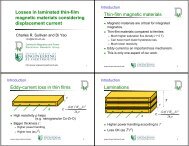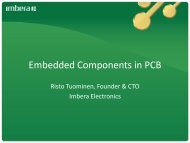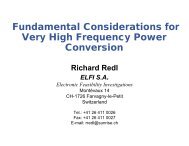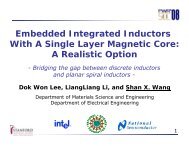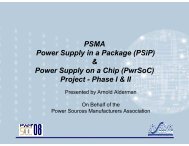Optimization and implementation of a multi-level buck converter for ...
Optimization and implementation of a multi-level buck converter for ...
Optimization and implementation of a multi-level buck converter for ...
Create successful ePaper yourself
Turn your PDF publications into a flip-book with our unique Google optimized e-Paper software.
International Workshop on Power Supply On Chip<br />
September 22nd - 24th, 2008, Cork, Irel<strong>and</strong><br />
<strong>Optimization</strong> <strong>and</strong> <strong>implementation</strong> <strong>of</strong> a <strong>multi</strong>-<strong>level</strong> <strong>buck</strong> <strong>converter</strong><br />
<strong>for</strong> st<strong>and</strong>ard CMOS on-chip integration<br />
Vahid Yousefzadeh,<br />
Toru Takayama<br />
Dragan Maksimović<br />
Colorado Power Electronics Center<br />
ECE Department, 425 UCB<br />
University <strong>of</strong> Colorado<br />
Boulder, CO 80309-0425<br />
maksimov@colorado.edu<br />
Gerard Villar<br />
Eduard Alarcón<br />
Dept. <strong>of</strong> Electronic Engineering<br />
Technical University <strong>of</strong> Catalunya<br />
Campus Nord UPC – Building C4<br />
08034 Barcelona, Spain<br />
ealarcon@eel.upc.edu
Outline<br />
• Introduction <strong>and</strong> motivation<br />
• Series-connected <strong>multi</strong>phase <strong>multi</strong><strong>level</strong> <strong>buck</strong> <strong>converter</strong><br />
– Ideal topology. Amplifier <strong>and</strong> regulator operation<br />
– Self-driven low-floating-capacitor PFM-operated 3-<strong>level</strong> <strong>converter</strong><br />
• Design-space optimization<br />
• Mixed-signal <strong>implementation</strong> in 0.25µm TSMC CMOS<br />
– Air-core bondingwire-based inductor, tapered buffer <strong>and</strong> transistor design<br />
– Inductor current zero-crossing detection circuit<br />
• Conclusions
Outline<br />
• Introduction <strong>and</strong> motivation<br />
• Series-connected <strong>multi</strong>phase <strong>multi</strong><strong>level</strong> <strong>buck</strong> <strong>converter</strong><br />
– Ideal topology. Amplifier <strong>and</strong> regulator operation<br />
– Self-driven low-floating-capacitor PFM-operated 3-<strong>level</strong> <strong>converter</strong><br />
• Design-space optimization<br />
• Mixed-signal <strong>implementation</strong> in 0.25µm TSMC CMOS<br />
– Air-core bondingwire-based inductor, tapered buffer <strong>and</strong> transistor design<br />
– Inductor current zero-crossing detection circuit<br />
• Conclusions
3-Level (2-cell) Buck Converter<br />
• 3-<strong>level</strong> (2-cell) <strong>converter</strong><br />
has been proposed <strong>for</strong> high<br />
voltage inverters [Meynard<br />
et al., 1992]<br />
•“g 1 -g 2 ” & “g 3 -g 4 ” are<br />
complementary switches<br />
• g 1 <strong>and</strong> g 3 have the same<br />
duty cycle<br />
• V C = ½ V in<br />
g 1<br />
g 3<br />
V SW<br />
V C V in V in -V CV in V C<br />
(D > 0.5)<br />
T s<br />
V in<br />
V in /2<br />
0 T s /2<br />
t<br />
• Objective:<br />
Investigate potential <strong>for</strong><br />
lower ripple/ higher<br />
efficiency / lower reactive<br />
component size / higher<br />
b<strong>and</strong>width realization <strong>of</strong><br />
DC-DC <strong>converter</strong>
Ripple comparison <strong>of</strong> 3-<strong>level</strong> <strong>and</strong> <strong>buck</strong> <strong>converter</strong> with same f s , L, C<br />
Inductor current ripple i<br />
1<br />
0.8<br />
0.6<br />
0.4<br />
0.2<br />
Switching Ripple in the 3-Level Buck Converter<br />
0<br />
0 0.1 0.2 0.3 0.4 0.5 0.6 0.7 0.8 0.9 1<br />
Duty cycle D<br />
4 times smaller peak inductor<br />
current ripple<br />
1<br />
∆imax_<br />
n = ∆i<br />
2<br />
n −1<br />
i 2<br />
i 3<br />
( )<br />
max_ 2<br />
Output voltage ripple v (mV)<br />
120<br />
100<br />
80<br />
60<br />
40<br />
20<br />
0<br />
0 0.1 0.2 0.3 0.4 0.5 0.6 0.7 0.8 0.9 1<br />
8 times smaller peak capacitor<br />
voltage ripple<br />
1<br />
∆vmax_<br />
n = ∆v<br />
3 max_ 2<br />
n −1<br />
( )<br />
Ripple results similar to two-phase <strong>converter</strong>, but with a single, smaller inductor
3-Level (2-cell) Buck Converter<br />
Comparison <strong>of</strong> 3-<strong>level</strong> <strong>and</strong> <strong>buck</strong> <strong>converter</strong><br />
• For ∆v max<br />
= 12 mV, f s_3<br />
= 200 kHz, f s_2<br />
= 560 kHz ⇒ η 2<br />
= 0.83 <strong>and</strong> η 3<br />
= 0.92<br />
⇒ improved efficiency<br />
• Same f s<br />
, ∆v o<br />
∆i L<br />
⇒ L 3<br />
= 0.25L 2<br />
, C 3<br />
=<br />
0.5C 2<br />
⇒ reduced area<br />
Example application to<br />
switching power amplifier
Two-Tone Signal Generation Using a<br />
3-Level <strong>and</strong> a Buck Converter<br />
A two-tone signal generated with a three-<strong>level</strong> <strong>and</strong> a <strong>buck</strong><br />
<strong>converter</strong>.<br />
Switching frequency, f s = 1MHz, f sig = 100kHz, f o = 550kHz, Q = 1
Experimental Envelope Tracking Wave<strong>for</strong>ms<br />
V out<br />
Frequency spectrum<br />
V out<br />
<strong>of</strong> V out<br />
Frequency spectrum<br />
<strong>of</strong> V out<br />
Harmonic components<br />
<strong>of</strong> rectified sinusoid<br />
Switching harmonics<br />
Harmonic components<br />
<strong>of</strong> rectified sinusoid<br />
Switching harmonics<br />
St<strong>and</strong>ard <strong>buck</strong> <strong>converter</strong><br />
3-<strong>level</strong> <strong>buck</strong> <strong>converter</strong><br />
• St<strong>and</strong>ard <strong>buck</strong> <strong>and</strong> 3-<strong>level</strong> <strong>buck</strong> compared <strong>for</strong> the same open-loop<br />
b<strong>and</strong>width <strong>and</strong> the same switching frequency<br />
• Modulation: rectified sine-wave at f m = 20 kHz<br />
• 30dB lower switching-frequency harmonic in the 3-<strong>level</strong> <strong>converter</strong>
Flying capacitor voltage control<br />
g 1<br />
sample<br />
sample<br />
V SW<br />
+<br />
_<br />
g 3<br />
V SW<br />
V in -V C<br />
V C<br />
V in -V C<br />
V C<br />
0 T s /2<br />
t<br />
• Digital (verilog) controller<br />
<strong>implementation</strong> using FPGA<br />
T s<br />
• x <strong>and</strong> y are sampled at<br />
V sw = V C or<br />
V sw = V in - V C<br />
V in<br />
V in /2<br />
C x<br />
g 3<br />
g 4<br />
g 1<br />
+<br />
V C<br />
V in -<br />
g 2<br />
g 1 =d(t)<br />
g 3 =d(t)+ d<br />
y<br />
x<br />
V in /2 - V q /2<br />
V SW<br />
+<br />
_<br />
V in /2 + V q /2
Experimental wave<strong>for</strong>ms <strong>for</strong><br />
flying capacitor voltage control<br />
V sw<br />
g 1<br />
V in<br />
-V c<br />
V c<br />
Uncontrolled<br />
capacitor C x<br />
voltage<br />
V in<br />
-V c<br />
V c<br />
D < 0.5<br />
g 3<br />
D > 0.5<br />
V sw<br />
g 1<br />
V in<br />
-V c<br />
V c<br />
Controlled<br />
capacitor C x<br />
voltage<br />
V in<br />
-V c<br />
V c<br />
g 3<br />
D > 0.5<br />
D < 0.5
Outline<br />
• Introduction <strong>and</strong> motivation<br />
• Series-connected <strong>multi</strong>phase <strong>multi</strong><strong>level</strong> <strong>buck</strong> <strong>converter</strong><br />
– Ideal topology. Amplifier <strong>and</strong> regulator operation<br />
– Self-driven low-floating-capacitor PFM-operated 3-<strong>level</strong> <strong>converter</strong><br />
• Design-space optimization<br />
• Mixed-signal <strong>implementation</strong> in 0.25µm TSMC CMOS<br />
– Air-core bondingwire-based inductor, tapered buffer <strong>and</strong> transistor design<br />
– Inductor current zero-crossing detection circuit<br />
• Conclusions
3-<strong>level</strong> self-driving PFM low-Cx <strong>buck</strong> <strong>converter</strong><br />
Low-C x resonant 3-<strong>level</strong> <strong>buck</strong> <strong>converter</strong> in DCM. Self-driving transistor-<strong>level</strong> topology<br />
Self-driving scheme to interconnect power transistors <strong>and</strong> drivers, which<br />
reduces the voltage across the power MOSFETs gate dielectric.
3-<strong>level</strong> self-driving PFM low-Cx <strong>buck</strong> <strong>converter</strong><br />
• Use <strong>of</strong> core transistors to implement the power MOSFETs<br />
• Use <strong>of</strong> core transistors to implement power drivers <strong>of</strong> P 2 & N 2<br />
• Reduces the power consumption <strong>of</strong> the power drivers<br />
37 MHz switching frequency<br />
26 nH inductance<br />
Driver supply voltage <strong>and</strong> vgs <strong>for</strong> all power MOSFETs,<br />
Cadence transistor-<strong>level</strong> simulations.
3-<strong>level</strong> self-driving PFM low-Cx <strong>buck</strong> <strong>converter</strong><br />
Output voltage ripple as a function <strong>of</strong> V o , <strong>for</strong><br />
the 3-<strong>level</strong> (C x sweep) <strong>and</strong> the classical<br />
(dotted line) Buck <strong>converter</strong>s.<br />
L=35nH<br />
C o<br />
=30nF<br />
f s<br />
=25MHz<br />
V bat<br />
=3.6V<br />
V o<br />
=1V<br />
I o<br />
=100mA<br />
Control signal-to-output voltage transfer<br />
function comparison between the 3-<strong>level</strong> (C x<br />
sweep) <strong>and</strong> the classical (dotted line) Buck<br />
<strong>converter</strong>s.<br />
Representative wave<strong>for</strong>ms corresponding to a DCM<br />
operated 3-<strong>level</strong> Buck <strong>converter</strong>, duty cycle below 50%
Outline<br />
• Introduction <strong>and</strong> motivation<br />
• Series-connected <strong>multi</strong>phase <strong>multi</strong><strong>level</strong> <strong>buck</strong> <strong>converter</strong><br />
– Ideal topology. Amplifier <strong>and</strong> regulator operation<br />
– Self-driven low-floating-capacitor PFM-operated 3-<strong>level</strong> <strong>converter</strong><br />
• Design-space optimization<br />
• Mixed-signal <strong>implementation</strong> in 0.25µm TSMC CMOS<br />
– Air-core bondingwire-based inductor, tapered buffer <strong>and</strong> transistor design<br />
– Inductor current zero-crossing detection circuit<br />
• Conclusions
Circuit topology considerations<br />
Optimized design space exploration (II)<br />
1) Model each per<strong>for</strong>mance index (ripple,<br />
efficiency <strong>and</strong> area) as a function <strong>of</strong> design<br />
parameters: inductor, capacitor <strong>and</strong><br />
switching frequency<br />
+<br />
i in<br />
+<br />
V in<br />
-<br />
iL<br />
R W +R C L<br />
Q 2<br />
Q 1<br />
T s =1/f s<br />
d(t)<br />
C<br />
i out<br />
+<br />
V out<br />
-<br />
R<br />
D=T on /T s<br />
∆v<br />
o<br />
=<br />
VoDT<br />
RC<br />
s<br />
=<br />
VoD<br />
RCf<br />
s<br />
=<br />
T on<br />
)<br />
A priori parameters <strong>and</strong> assumptions are application-oriented:<br />
topology, V in , V out , <strong>and</strong> the target IC technology parameters.<br />
Output voltage ripple<br />
f<br />
∆v<br />
o<br />
( L,<br />
C,<br />
fs<br />
)<br />
Efficiency<br />
Occupied area<br />
Vin<br />
I<br />
L<br />
− PL<br />
−DC<br />
− PL<br />
−core<br />
− PQ<br />
−all<br />
η =<br />
=<br />
V I<br />
in<br />
L<br />
f<br />
η<br />
( L,<br />
C,<br />
f<br />
s<br />
Area = AC<br />
+ AL<br />
+ 2AQ<br />
= farea<br />
( L,<br />
C,<br />
fs<br />
)
Circuit topology considerations<br />
Optimized design space exploration (III)<br />
2) Define a merit figure encompassing the<br />
per<strong>for</strong>mance indexes to be maximized or<br />
minimized<br />
Output<br />
voltage<br />
ripple<br />
f<br />
L<br />
C<br />
f<br />
C<br />
L<br />
generic merit figure<br />
Γ(<br />
x<br />
x ) =<br />
∏<br />
i<br />
∏<br />
β f<br />
γ i<br />
i<br />
1,...,<br />
n<br />
γ j<br />
β<br />
j<br />
f<br />
j<br />
j<br />
i<br />
( x<br />
( x<br />
1,...,<br />
1,...,<br />
Boost <strong>converter</strong> case example merit figure<br />
x<br />
x<br />
n<br />
n<br />
)<br />
)<br />
Efficiency<br />
Occupied<br />
area<br />
∆v o<br />
η<br />
A<br />
f<br />
L<br />
L<br />
f<br />
C<br />
C<br />
f<br />
f<br />
C<br />
C<br />
L<br />
L<br />
fη<br />
( L,<br />
C,<br />
fs<br />
)<br />
Γ( L,<br />
C,<br />
fs)<br />
=<br />
2<br />
f ( L,<br />
C,<br />
f ) ⋅ f ( L,<br />
C,<br />
f<br />
A<br />
s<br />
∆v<br />
Note that the area dependence is square-weighted<br />
so as to solve the ill-conditioned solution <strong>of</strong><br />
∆vo→∞ when A→0.<br />
o<br />
s<br />
)<br />
Merit<br />
figure<br />
Γ<br />
f<br />
L<br />
f s<br />
={1MHz,100MHz}, L={10nH,1uH}, C={10pF,10nF}<br />
C<br />
f<br />
C<br />
L
Circuit topology considerations<br />
Optimized design space exploration (IV)<br />
Design example <strong>for</strong> a st<strong>and</strong>ard 0.35 µm CMOS technology<br />
3) Obtain optimum point within<br />
design space (L,C, f s<br />
) as regards<br />
efficiency, occupied area,<br />
functionality<br />
V out<br />
(V)<br />
I L<br />
(A)<br />
Specs: ∆ vo<br />
=0.1 V i out<br />
=0.4 A<br />
<strong>Optimization</strong> result: L= 30 nH, C= , f s = 50 MHz<br />
+<br />
i L<br />
i in 0.82 Ω 30 nH<br />
2.5 V<br />
W=3352 µm<br />
L=0.35 µm<br />
k core=221⋅10 -11<br />
δ L=0.04 H/m 2 W=3352 µm<br />
L=0.35 µm<br />
W=2500 µm<br />
L=2500 µm<br />
i out<br />
+<br />
3.3 V<br />
- 16.5Ω
Optimized design space exploration<br />
3-<strong>level</strong> <strong>converter</strong> design example <strong>for</strong> a st<strong>and</strong>ard 0.25 µm CMOS technology<br />
Design space exploration <strong>of</strong> a CMOS-compatible 3-<strong>level</strong><br />
<strong>converter</strong>: 70% efficiency, 5mm 2 silicon <strong>and</strong> f s =37 MHz
Outline<br />
• Introduction <strong>and</strong> motivation<br />
• Series-connected <strong>multi</strong>phase <strong>multi</strong><strong>level</strong> <strong>buck</strong> <strong>converter</strong><br />
– Ideal topology. Amplifier <strong>and</strong> regulator operation<br />
– Self-driven low-floating-capacitor PFM-operated 3-<strong>level</strong> <strong>converter</strong><br />
• Design-space optimization<br />
• Mixed-signal <strong>implementation</strong> in 0.25µm TSMC CMOS<br />
– Air-core bondingwire-based inductor, tapered buffer <strong>and</strong> transistor design<br />
– Inductor current zero-crossing detection circuit<br />
• Conclusions
Bondwire triangular spiral inductors in st<strong>and</strong>ard CMOS<br />
•Area underneath inductor is usable <strong>for</strong> capacitors <strong>and</strong> power MOSFETs
Power MOSFETs<br />
Complete loss optimization <strong>of</strong> on-chip CMOS synchronous rectifier<br />
W P = 3092µm<br />
W N = 2913µm power<br />
drivers with 7.59 <strong>and</strong> 7.48 tapering factors<br />
Overall losses 37.1mW<br />
Breakdown <strong>of</strong> loss distribution, corresponding<br />
the optimized design <strong>of</strong> power MOSFETs <strong>and</strong><br />
their associated drivers.
Power MOSFET gate drive design<br />
Additional degree <strong>of</strong> freedom: impact <strong>of</strong> W p<br />
upon efficiency <strong>and</strong> delay<br />
Q i<br />
<strong>and</strong> Q e1<br />
variation as a function <strong>of</strong> the PMOS channel<br />
width <strong>of</strong> the minimum inverter (W n<br />
= 0.3µm)<br />
t fri<br />
<strong>and</strong> t fre1<br />
parameter variation<br />
Total energy losses as a function <strong>of</strong> the number <strong>of</strong> inverters n <strong>and</strong> the<br />
minimum inverter PMOS channel width W p<br />
. The area includes all the<br />
designs constrainted to a propagation delay lower than 1.15 ns.
iL=0 detection circuit. Event detection<br />
i L >0<br />
i L
iL=0 detection circuit. Circuit <strong>for</strong> time adjustment. Inductor current observer
iL=0 detection circuit Mixed-signal <strong>implementation</strong> in 0.25µm CMOS<br />
i L >0<br />
N 1<br />
N 2<br />
7.9<br />
i L
Time-domain per<strong>for</strong>mance <strong>of</strong> iL=0 detection circuit<br />
Be<strong>for</strong>e adjustment<br />
After iL=0 adjustment<br />
7.10
Complete integrated 3-<strong>level</strong> CMOS switching power <strong>converter</strong><br />
P 1<br />
2630 µm<br />
2370<br />
µm<br />
P 2<br />
N 1<br />
N2 7.17
Full-transistor-<strong>level</strong> circuit results (I)<br />
7.19
Full-transistor-<strong>level</strong> circuit results (II)<br />
7.20
Full-transistor-<strong>level</strong> circuit results (III)<br />
7.21
Experimental results
Outline<br />
• Introduction <strong>and</strong> motivation<br />
• Series-connected <strong>multi</strong>phase <strong>multi</strong><strong>level</strong> <strong>buck</strong> <strong>converter</strong><br />
– Ideal topology. Amplifier <strong>and</strong> regulator operation<br />
– Self-driven low-floating-capacitor PFM-operated 3-<strong>level</strong> <strong>converter</strong><br />
• Design-space optimization<br />
• Mixed-signal <strong>implementation</strong> in 0.25µm TSMC CMOS<br />
– Air-core bondingwire-based inductor, tapered buffer <strong>and</strong> transistor design<br />
– Inductor current zero-crossing detection circuit<br />
• Conclusions
Conclusions<br />
• Three-<strong>level</strong> <strong>converter</strong> results in favorable trade-<strong>of</strong>fs in terms <strong>of</strong> decreasing the switching ripples,<br />
decreasing the switching frequency, reducing the size <strong>of</strong> the filter elements, increasing the<br />
<strong>converter</strong> open-loop b<strong>and</strong>width, or increasing the <strong>converter</strong> efficiency.<br />
• The 3-<strong>level</strong> <strong>converter</strong> with low-Cx, self-biased drivers <strong>and</strong> operating in DCM/PFM has been<br />
presented as a c<strong>and</strong>idate <strong>for</strong> DC-DC <strong>converter</strong> integration<br />
• The use <strong>of</strong> the self-driving scheme to supply the drivers allows the use <strong>of</strong> thin-oxide transistors<br />
which increases the per<strong>for</strong>mance <strong>of</strong> the switches.<br />
• Design optimization results in the 3-<strong>level</strong> <strong>converter</strong> outper<strong>for</strong>ming the Buck <strong>converter</strong>.<br />
Future research lines<br />
• Linear-assisted scheme <strong>for</strong> <strong>multi</strong><strong>level</strong> <strong>converter</strong>s<br />
• Explore extending the approach to more intermediate <strong>level</strong>s<br />
• Use different modulations (e.g. asynchronous sigma delta)<br />
• Applying time optimal control


